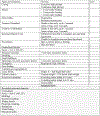Pharmacological and non-pharmacological treatments for the Neonatal Abstinence Syndrome (NAS)
- PMID: 30745219
- PMCID: PMC6451887
- DOI: 10.1016/j.siny.2019.01.009
Pharmacological and non-pharmacological treatments for the Neonatal Abstinence Syndrome (NAS)
Abstract
Neonatal abstinence syndrome is defined by signs and symptoms of withdrawal that infants develop after intrauterine maternal drug exposure. All infants with documented in utero opioid exposure, or a high pre-test probability of exposure should have monitoring with a standard assessment instrument such as a Finnegan Score. A Finnegan score of >8 is suggestive of opioid exposure, even in the absence of declared use during pregnancy. At least half of infants in most locales can be treated without the use of pharmacologic means. For this reason, symptom scores will drive the decision for pharmacologic therapy. Nevertheless, all infants, regardless of initial manifestations, should be first be managed with non-pharmacologic approaches which in turn, should not be considered as the sole alternative to drug therapy, but rather, as the base upon which all patients are treated. Those who continue to have symptoms despite supportive care should be pharmacologically treated, which in the most severe cases, is life-saving.
Keywords: Infant; Neonatal abstience syndrome; Opioid.
© 2019 Elsevier Ltd. All rights reserved.
Conflict of interest statement
Conflict of Interest: None
Figures




References
-
- Hudak ML, Tan RC; The Committee On Drugs; The Committee On Fetus And Newborn; American Academy of Pediatrics. Neonatal drug withdrawal. Pediatrics. 2012;129(2):e540–e560. - PubMed
-
- Neonatal opioid withdrawal syndrome and medication-assisted treatment with methadone and buprenorphine. https://www.fda.gov/Drugs/DrugSafety/ucm503630.htm
-
- Cleary BJ, Donnelly J, Strawbridge J, et al. Methadone dose and neonatal abstinence syndrome-systematic review and meta-analysis. Addiction 2010;105(12):2071–84. - PubMed
-
- Finnegan LP. A scoring system for evaluation and treatment of neonatal abstinence syndrome: A new clinical and research tool In Morselli PL, Garattini S, and Sarani F (eds.): Basics and Therapeutic Aspects of Perinatal Pharmacology. 1975. Raven Press; New York.

